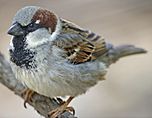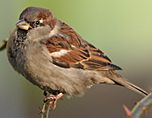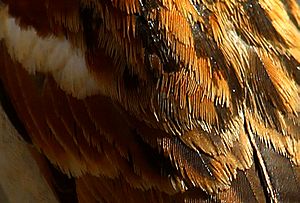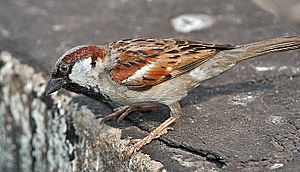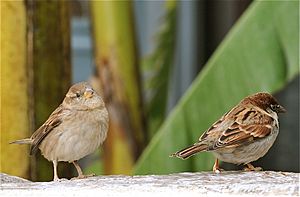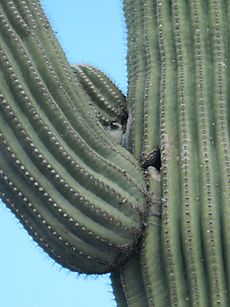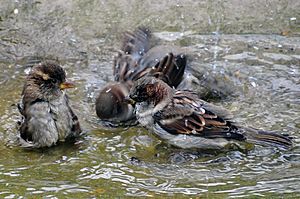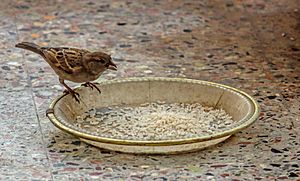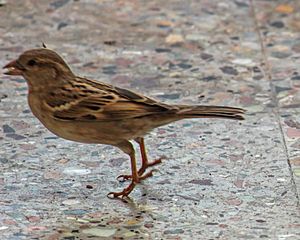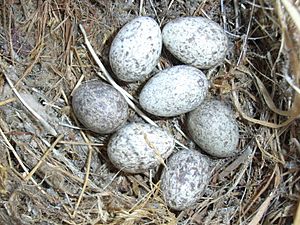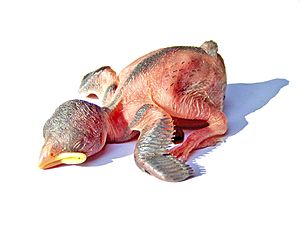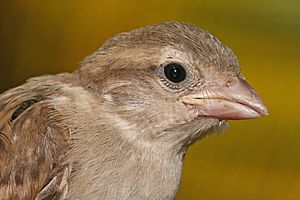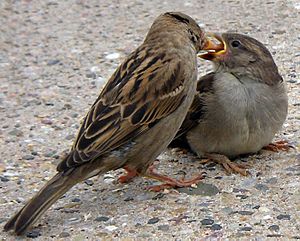House sparrow facts for kids
Quick facts for kids House sparrow |
|
|---|---|
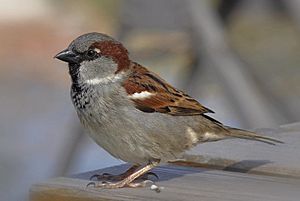 |
|
| Male in Germany | |
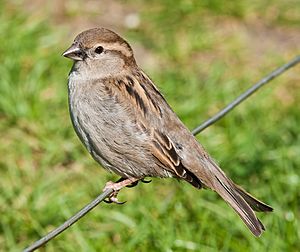 |
|
| Female in England | |
| Conservation status | |
| Scientific classification | |
| Genus: |
Passer
|
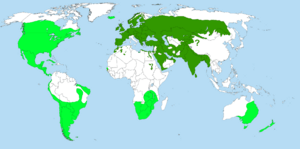 |
|
|
Native range
Introduced range |
|
| Synonyms | |
|
Fringilla domestica Linnaeus, 1758 |
|
The house sparrow (Passer domesticus) is a small bird that belongs to the sparrow family. You can find them in most parts of the world. These birds are usually about 16 centimeters (6.3 inches) long and weigh between 24 and 39.5 grams (0.8 to 1.4 ounces).
Female and young sparrows are pale brown and grey. Male sparrows have brighter markings in black, white, and brown. The house sparrow is one of about 25 types of sparrows in the Passer group. It originally came from Europe, the Mediterranean area, and a large part of Asia.
House sparrows have been brought to many other places, like Australia, Africa, and the Americas. This makes them the most widespread wild bird on Earth. They often live near people, whether in cities or on farms. They usually avoid large woodlands, grasslands, and deserts far from human areas.
House sparrows mainly eat seeds from grains and weeds. However, they are good at finding food and also eat insects and many other things. Domestic cats, hawks, owls, and other predatory birds and mammals hunt them.
Because there are so many house sparrows and they live everywhere, they are well-known. People have tried to get rid of them as farm pests, but usually without success. Some people have even kept them as pets. Even though they are common, their numbers have gone down in some areas. The conservation status of the house sparrow is listed as "least concern" on the IUCN Red List. This means they are not currently at risk of disappearing.
Contents
What Does a House Sparrow Look Like?
Size and Shape of House Sparrows
A house sparrow is typically about 16 centimeters (6.3 inches) long. They can range from 14 to 18 centimeters (5.5 to 7.1 inches). They are sturdy birds with a full chest and a large, round head. Their beak is strong and cone-shaped, perfect for eating seeds. The beak is about 1.1 to 1.5 centimeters (0.43 to 0.59 inches) long.
Their tail is short, measuring about 5.2 to 6.5 centimeters (2.0 to 2.6 inches). The wing length is 6.7 to 8.9 centimeters (2.6 to 3.5 inches). Their leg (tarsus) is 1.6 to 2.5 centimeters (0.63 to 0.98 inches) long. House sparrows weigh from 24 to 39.5 grams (0.85 to 1.39 ounces). Females are usually a bit smaller than males.
Birds living in colder places or higher altitudes tend to be larger. This is a common pattern seen in many animal species.
House Sparrow Plumage (Feathers)
The feathers of a house sparrow are mostly shades of grey and brown. Male and female sparrows look quite different. The female is mostly a pale, yellowish-brown color all over. The male has bold, bright markings on its head, a reddish-brown back, and grey underparts.
The male has a dark grey cap on its head, from its beak to its back. Chestnut brown feathers are on the sides of its head. It has black feathers around its beak, on its throat, and between its beak and eyes. There is a small white stripe near its eyes and small white spots behind them. Its belly is pale grey or white, as are its cheeks and the stripes at the base of its head. The upper back is warm brown with black stripes.
When the male is not in breeding season, its colors are duller. White tips on many feathers hide the brighter colors. As feathers wear down, the bright brown and black markings show through. This includes the black patch on its throat and chest, called the "bib" or "badge." This bib can vary in size and might show a bird's social status. Studies have shown that these patches get bigger as the bird gets older. The male's beak is black during breeding season and dark grey the rest of the year.
The female house sparrow does not have black markings or a grey cap. Her upper parts and head are brown with darker streaks. She has a clear pale stripe above her eye. Her underparts are pale grey-brown. The female's beak is brownish-grey and gets darker during breeding season.
Young sparrows look similar to adult females. They are a deeper brown underneath and paler on top. Their eye stripes are less clear. Young males might have darker throats and white spots behind their eyes, like adult males. However, it's hard to tell the sex of young birds just by their feathers. The beaks of young birds are light yellow. By their first breeding season, young birds usually look like adults.
House Sparrow Sounds
Most house sparrow calls are short, constant chirps. You might hear them as chirrup, tschilp, or philip. These calls are used by birds in a flock or when resting. Males also use this call to show they own a nest and to attract a mate. During breeding season, the male repeats this call quickly and with emphasis.
Aggressive males make a trilled version of their call, like "chur-chur-r-r-it-it-it-it". Females also use this call during breeding season to show dominance over males. House sparrows have a nasal alarm call, which sounds like quer. They make a shrill chree sound when they are very scared. Another sound is the "appeasement call," a soft quee. This call helps stop fights, usually between a mated pair. These sounds are common among all sparrows.
Different Kinds of House Sparrows
There are 12 recognized types, or subspecies, of house sparrows. They are divided into two main groups: the P. d. indicus group from Asia and the P. d. domesticus group from Europe and northern Asia. Birds in the P. d. domesticus group have grey cheeks. Birds in the P. d. indicus group have white cheeks. They also have brighter colors on their heads, smaller beaks, and longer black bibs.
Some subspecies have small differences. For example, P. d. tingitanus males have speckled black heads when breeding. P. d. balearoibericus is a bit paler than the main type. P. d. bibilicus is paler than most, but still has grey cheeks.
Some house sparrows, like P. d. bactrianus, migrate long distances. They are found in open areas, not usually near people. Other subspecies, like P. d. indicus, are found in the Indian subcontinent and other parts of Asia.
How to Tell House Sparrows Apart
It can be tricky to tell a house sparrow from other seed-eating birds, especially its relatives. Many related sparrows are smaller and look "neater." Female house sparrows can be hard to tell apart from females of the Spanish and Italian sparrows.
The Eurasian tree sparrow is smaller and thinner. It has a chestnut-colored cap and a black patch on each cheek. Male Spanish and Italian sparrows have chestnut-colored caps, which helps tell them apart. The Sind sparrow is very similar but smaller. The male Sind sparrow has less black on its throat, and the female has a clear pale stripe above its eye.
House Sparrow Classification
Naming the House Sparrow
The house sparrow was one of the first animals to get a scientific name in the modern system of biological classification. This happened when Carl Linnaeus described it in 1758. He named it Fringilla domestica. Later, the name Fringilla was used only for the common chaffinch. The house sparrow was then placed in the group Passer, created by French zoologist Mathurin Jacques Brisson in 1760.
The scientific name and the common English name mean the same thing. The Latin word passer means a small, active bird. The Latin word domesticus means "belonging to the house," showing its connection to humans.
House sparrows have other names, too. In North America, they are often called English sparrow. In the Indian subcontinent and Central Asia, they are called Indian sparrow. Some local names include sparr, spadger, spug, and spatzie.
House Sparrow Family Tree
The Passer group includes about 25 to 26 different species of sparrows. Most Passer species are dull-colored birds with short, square tails and strong, cone-shaped beaks. They are usually between 11 and 18 centimeters (4.3 and 7.1 inches) long.
Studies of their DNA suggest that these species developed over a long time, possibly during the Ice Age. The house sparrow is part of a group called "Palaearctic black-bibbed sparrows." It is closely related to the Mediterranean "willow sparrows."
The way house sparrows and their Mediterranean relatives are classified is complex. The Spanish sparrow is a common "willow sparrow." It looks a lot like the house sparrow. Spanish sparrows often prefer wetter places and live in large groups. In the Mediterranean, these two species sometimes breed together, creating mixed populations.
In most of Italy, the main breeding sparrow is the Italian sparrow. This bird looks like a mix between the house sparrow and the Spanish sparrow. Scientists are still debating where it came from. It might be a new species that formed from ancient cross-breeding.
House Sparrow Subspecies
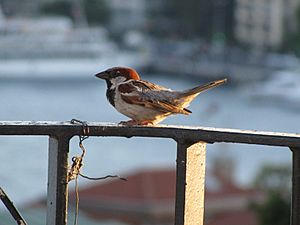
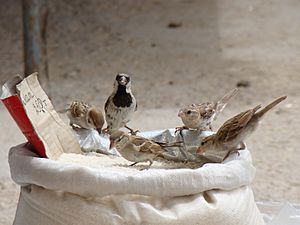
Many subspecies of house sparrows have been named. Twelve are currently recognized. These are divided into two main groups: the P. d. domesticus group from Europe and northern Asia, and the P. d. indicus group from Asia. Some Middle Eastern subspecies are sometimes seen as a third, in-between group.
In the 1970s, scientists noticed that migratory P. d. bactrianus birds and P. d. domesticus birds lived in the same areas without breeding together. This led some to suggest that the P. d. indicus group should be a separate species. However, since these groups do interbreed in parts of Iran, this idea is not widely accepted.
In North America, house sparrow populations show differences. Birds in colder, northern areas are larger. Birds in dry areas are paler. It's not fully clear if these differences are due to evolution or just the environment. Similar patterns are seen in New Zealand and South Africa.
Here are some of the recognized subspecies:
- P. d. domesticus group
- P. d. domesticus: Found in most of Europe and northern Asia. This is the most common type that has been introduced to new places.
- P. d. balearoibericus: Found in the Balearic Islands, southern France, the Balkans, and Anatolia.
- P. d. tingitanus: Found in North Africa. It often breeds with the Spanish sparrow.
- P. d. niloticus: Found along the Nile River in Egypt and Sudan.
- P. d. persicus: Found in western and central Iran.
- P. d. biblicus: Found in the Middle East, from Cyprus to Kuwait.
- P. d. indicus group
- P. d. hyrcanus: Found along the southern coast of the Caspian Sea in Iran and Azerbaijan. It has the smallest range of all subspecies.
- P. d. bactrianus: Found in southern Kazakhstan and parts of Iran and Afghanistan. Unlike most house sparrows, it migrates for winter. It lives in open country, not usually near people.
- P. d. parkini: Found in the western Himalayas. It also migrates.
- P. d. indicus: Found in the Indian subcontinent, Sri Lanka, Southeast Asia, and parts of Arabia and Israel.
- P. d. hufufae: Found in northeastern Arabia.
- P. d. rufidorsalis: Found in the Nile valley in Sudan and Ethiopia. It has also been introduced to Mohéli in the Comoros.
Where House Sparrows Live
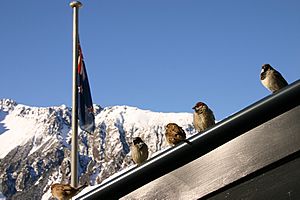
House sparrows first appeared in the Middle East. They spread across Europe and Asia as farming grew. Since the mid-1800s, they have reached most of the world. This happened because people purposely brought them to new places. They also spread naturally or by traveling on ships.
Their introduced range now covers most of North America, Central and South America, southern Africa, Australia, New Zealand, and many islands. They have greatly expanded their range in northern Europe and Asia since the 1850s. For example, they settled in Iceland and Rishiri Island, Japan, around 1990. Because they live in so many places, they are the most widespread wild bird on Earth.
How House Sparrows Spread
The house sparrow has been very successful in most places where it was introduced. This is mainly because they adapted early to living with humans. They can also adjust to many different conditions. They might also have a strong immune system compared to other sparrows.
When introduced, they can spread quickly, sometimes over 230 kilometers (140 miles) per year. In many parts of the world, they are seen as a pest. They can also be a threat to native birds. However, some introductions have failed, like in Greenland.
The first successful introduction to North America happened in New York City in 1852. Birds from England were released to help control a type of moth. Now, house sparrows live from Canada to southern Panama. They are one of the most common birds in North America.
House sparrows were first brought to Australia in 1863 in Melbourne. They are common in eastern Australia. However, they have been stopped from settling in Western Australia, where any found are removed. They arrived in New Zealand in 1859. From there, they spread to many Pacific islands, including Hawaii.
In southern Africa, both European and Indian subspecies were introduced around 1900. The European type stays in a few towns. The Indian type has spread quickly, reaching Tanzania in the 1980s. In South America, they were first introduced near Buenos Aires around 1870. They quickly became common across the southern part of the continent.
Where House Sparrows Live (Habitat)
House sparrows live very closely with humans and our farms. They are not always dependent on humans, though. Some migratory sparrows in Central Asia breed away from people in open areas. Other sparrows are sometimes found away from human settlements.
The only land habitats house sparrows don't live in are dense forests and very cold, treeless areas (tundra). They are very good at living around people. They often live and even breed inside buildings like factories, warehouses, and zoos. One was even found breeding in an English coal mine 640 meters (2,100 feet) underground!
They are most common in cities. However, they have more success raising young in suburbs, where there are more insects. They are most abundant in areas where wheat is grown.
House sparrows can live in many different climates. They prefer drier conditions, especially in moist tropical areas. They have ways to survive in dry places, like being able to handle a lot of salt. They can also live without water by eating berries. In most of eastern Asia, the house sparrow is replaced by the Eurasian tree sparrow.
Where these two species live in the same area, the house sparrow is usually more common. However, sometimes one species replaces the other in a way that seems random. In most of its range, the house sparrow is very common. But in difficult habitats, like rainforests or mountains, their numbers can be scattered.
House Sparrow Behavior
Social Life of House Sparrows
House sparrows are very social birds. They like to be in groups all year round, especially when they are eating. They often join flocks with other bird species. They sleep together in groups in trees or bushes. Their nests are usually built close together. They also do social things like bathing in dust or water, and "social singing." This is when many birds call together in bushes.
House sparrows mostly eat on the ground. But they gather in trees and bushes. At feeding spots and nests, female house sparrows are usually in charge, even though they are smaller. They can even fight over males during the breeding season.
Sleeping and Roosting Habits
House sparrows sleep with their beak tucked under their shoulder feathers. When it's not breeding season, they often sleep together in trees or shrubs. There's a lot of chirping before and after they settle down for the night. They also chirp before leaving their sleeping spot in the morning. Sometimes, they visit other gathering places before going to sleep.
Keeping Clean
Bathing in dust or water is common for house sparrows. They often do this in groups. They rarely do "anting," which is when birds rub ants on their feathers. When they scratch their head, they bring their leg over their wing.
What House Sparrows Eat
Adult house sparrows mostly eat the seeds of grains and weeds. But they are very adaptable and will eat whatever food is available. In towns and cities, they often search for food in garbage cans. They also gather outside restaurants to eat leftover food and crumbs.
They can do clever things to get food. For example, they might open automatic doors to enter supermarkets. They can also cling to hotel walls to watch people on balconies. Like many birds, house sparrows need grit to help digest hard foods. Grit can be small stones or pieces of eggshells or snail shells.
Studies in farm areas show that about 90% of their diet is seeds. They will eat almost any seeds. But if they have a choice, they prefer oats and wheat. In cities, they eat a lot of food given by humans, like bread. However, they still prefer raw seeds. House sparrows also eat other plant parts, like buds, berries, and fruits. In spring, they sometimes tear up flowers, especially yellow ones.
Animals are another important part of their diet. They mainly eat insects, such as beetles, caterpillars, flies, and aphids. They also eat other small creatures like molluscs, crustaceans, earthworms, and even small vertebrates like lizards and frogs.
Young house sparrows are fed mostly insects until they are about 15 days old. They also get small amounts of seeds, spiders, and grit. In most places, grasshoppers and crickets are the most common foods for baby birds. House sparrows have even been seen stealing food from other birds.
How House Sparrows Move
The house sparrow's flight is straight and involves constant flapping. They fly at about 45.5 kilometers per hour (28.3 mph). They flap their wings about 15 times per second. On the ground, house sparrows usually hop instead of walking. They can swim if they are being chased by predators. Captive birds have even been seen diving and swimming short distances underwater.
Travel and Migration
Most house sparrows do not move more than a few kilometers in their lives. However, some limited travel happens in all areas. Some young birds travel long distances, especially along coasts. Mountain birds move to lower areas in winter. Two subspecies, P. d. bactrianus and P. d. parkini, mostly migrate. Unlike sparrows that stay in one place, migratory sparrows gain weight to prepare for their journey.
House Sparrow Reproduction and Life Cycle
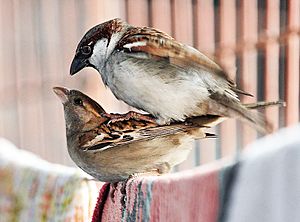
House sparrows can start breeding in the season right after they hatch. Sometimes, they even try to breed when they are just a few months old. Birds breeding for the first time are not usually successful at raising young. Success improves with age, as older birds breed earlier and raise more young.
As breeding season nears, male sparrows start calling often near nesting spots. Unmated males begin building a nest and call loudly to attract females. When a female comes near, the male shows off. He moves up and down, droops and shakes his wings, raises his head, spreads his tail, and shows his black bib. Males might try to mate with females while displaying. Females might act aggressive and fly away, with the male following.
House sparrows are usually monogamous, meaning they mate for life. However, about 15% of young sparrows are not related to their mother's mate. The pair bond is linked to holding a nest site. But mated sparrows can recognize each other away from the nest.
Nesting Habits
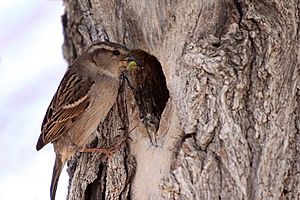
House sparrows use many different places for nests, but they prefer holes or cavities. Nests are most often built in the eaves (overhangs) and cracks of houses. Holes in cliffs, banks, or tree hollows are also used. A sparrow might dig its own nest in sandy banks or rotten branches. More often, it uses nests of other birds, like those of swallows or old tree nests.
They usually use empty nests. But sometimes, they take over active ones by chasing away or killing the birds living there. Tree hollows are used more in North America than in Europe. This puts sparrows in competition with other birds that nest in holes.
In warmer areas, house sparrows might build nests in the open. They build them on tree branches, especially evergreens or hawthorns. They also use the nests of large birds like storks or magpies. Nests built in the open are less successful. They start later and can be easily damaged by storms. Less common nest sites include street lights and neon signs, which they like for their warmth. They also use old, open nests of other songbirds and then build a dome over them.
The nest is usually dome-shaped, but it might not have a roof in enclosed spots. It has an outer layer of stems and roots. The middle layer is dead grass and leaves. The inside is lined with feathers, paper, and other soft materials. Nests are typically about 20 × 30 cm (8 × 12 in) in size, but they can vary a lot.
The male starts building the nest while trying to attract females. The female helps build, but the male does more work. Some nest building happens all year, especially after they lose old feathers in autumn. In colder places, house sparrows build special roost nests or sleep in street lights to stay warm in winter. House sparrows don't defend a large territory. But they aggressively protect their nests from other sparrows of the same sex.
House sparrow nests are home to many insects. These include nest flies and over 1,400 types of beetles.
Eggs and Young Birds
A clutch usually has four or five eggs. However, anywhere from one to 10 eggs have been seen. They usually lay at least two clutches a year. In tropical areas, they might lay up to seven clutches. In colder places, they might lay four clutches a year. When fewer clutches are laid, especially in colder areas, each clutch has more eggs. House sparrows in Central Asia, who migrate and only have one clutch a year, average 6.5 eggs per clutch. The number of eggs also depends on the environment, the season, the female's age, and how many sparrows are in the area.
Sometimes, females lay eggs in the nests of other sparrows. If a nest has an unusually large number of eggs, this might be why. Females sometimes recognize these foreign eggs and push them out. House sparrows are rarely victims of other birds laying eggs in their nests. This is because their nest holes are usually too small for other birds to enter. Also, they feed their young food that is not suitable for other birds' babies.
The eggs are white, bluish-white, or greenish-white, with brown or grey spots. They are oval-shaped. They are about 20 to 22 mm (0.79 to 0.87 in) long and 14 to 16 mm (0.55 to 0.63 in) wide. They weigh about 2.9 grams (0.10 oz). Eggs from tropical subspecies are smaller. Eggs laid later in a clutch are larger. Larger females also lay larger eggs, and egg size can be passed down from parents. Eggs get slightly smaller from the time they are laid until they hatch. The yolk makes up 25% of the egg, the egg white 68%, and the shell 7%. Eggs are mostly liquid (79%) and protein.
The female develops a bare patch of skin on her belly. She does most of the incubating (keeping the eggs warm). The male helps, but he can only cover the eggs, not truly incubate them. The female stays on the nest all night during this time. The male sleeps near the nest.
Eggs hatch at the same time after a short incubation period. This usually lasts 11–14 days, but can be as short as 9 or as long as 17 days. The warmer the weather, the shorter the incubation period.
Young house sparrows stay in the nest for 11 to 23 days, usually 14 to 16 days. Both parents feed them during this time. Newborn sparrows don't have enough feathers to stay warm, so they are kept warm by their parents for a few days. This can be longer if it's cold. The parents eat the droppings (poop) of the baby birds for the first few days. Later, they move the droppings up to 20 meters (66 feet) away from the nest.
The chicks' eyes open after about 4 days. At about 8 days old, they get their first soft down feathers. If both parents die, the loud begging sounds of the young often attract other adult sparrows. These new parents will feed them until they can take care of themselves. All the young birds in a nest usually leave at the same time, within a few hours. At this point, they can usually fly. They start feeding themselves partly after 1 or 2 days. They can fully feed themselves after 7 to 10 days, or 14 days at the latest.
House Sparrow Survival
Adult house sparrows have a 45–65% chance of surviving each year. After leaving the nest and their parents, young sparrows have a high chance of dying. This risk goes down as they get older and more experienced. Only about 20–25% of hatched birds survive to their first breeding season.
The oldest known wild house sparrow lived for almost 20 years. It was found dead 19 years and 9 months after it was tagged in Denmark. The oldest house sparrow kept in captivity lived for 23 years. It's hard to know the exact number of males to females in a population. But usually, there are slightly more males at all ages.
Who Hunts House Sparrows?
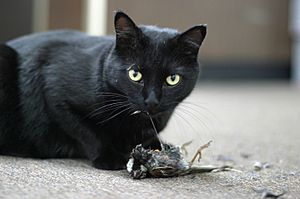
The main hunters of house sparrows are cats and birds of prey. But many other animals also hunt them. These include crows and jays, squirrels, and even humans. In the past, people in many parts of the world ate house sparrows. They are still eaten in some parts of the Mediterranean.
Many types of birds of prey hunt house sparrows. Accipiter hawks and the merlin are especially big predators. However, cats probably have a greater impact on house sparrow numbers. House sparrows are also often hit by cars. On European roads, they are the bird most commonly found dead.
Images for kids
-
Female bringing food for young in a tree hole nest in California
See also
 In Spanish: Gorrión común para niños
In Spanish: Gorrión común para niños



